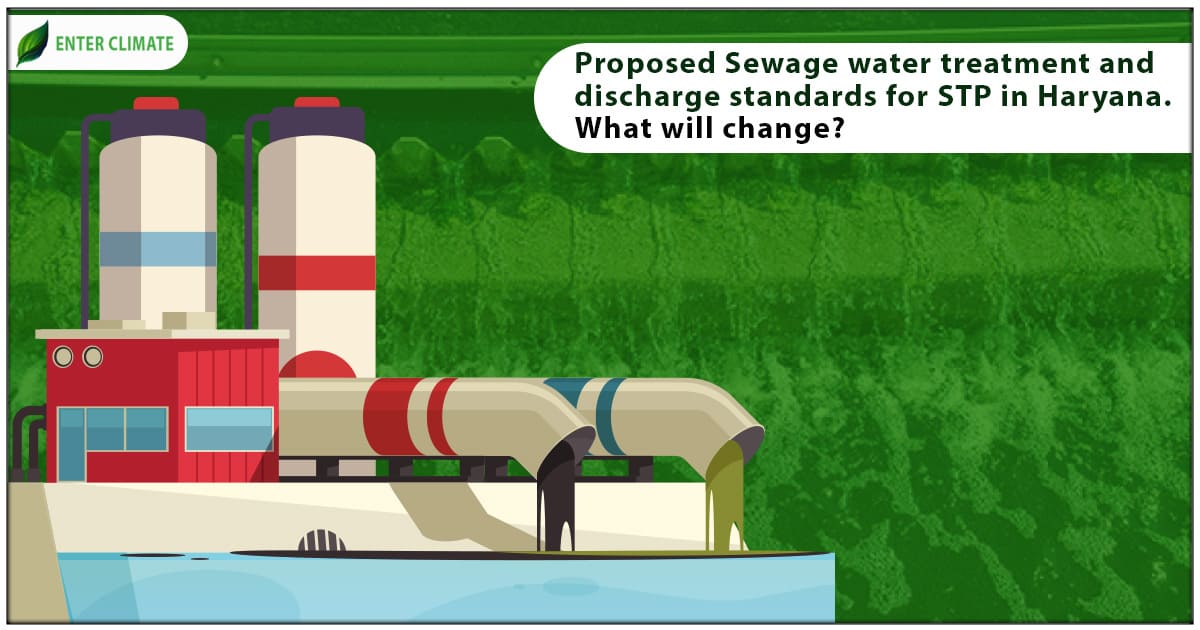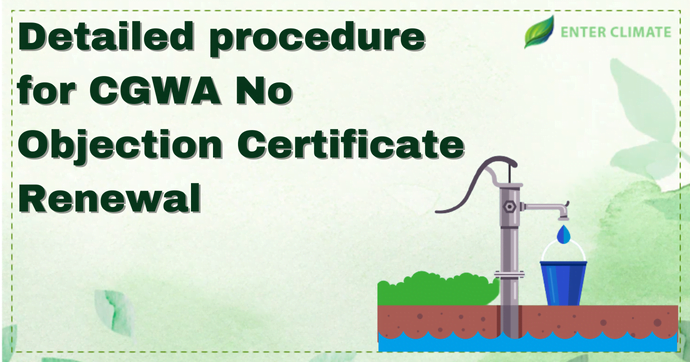Proposed Sewage water treatment and discharge standards for STP in Haryana. What will change?
 01 Jun, 2023
01 Jun, 2023 
Sewage, also known as “wastewater, ” is water-carried waste, in solution or suspension, intended to be removed from the community. Sewerage refers to the infrastructure that carries sewage. It encompasses components such as sewers, manholes, pumping stations and sewage treatment plants. Industrial areas generate effluents as well as solid waste. Smaller industrial units discharge polluting effluents, which may share the infrastructure by pooling for Common Effluent Treatment Plants (CETP). At the same time, more prominent industries may be required to set up their own Effluent Treatment facilities. The Haryana State Pollution Control Board adopted the standard for emission pollutants as prescribed under Section 3 of Environment (Protection) Rules, 1986. As per the policy on the reuse of treated wastewater by the Haryana government released in May 2019 for assessment of the discharge standards for STP, there are presently 144 STPs installed by PHED/HSVP/ULBs/GMDA having a collective capacity of 1802.70 MLD.
Role of Haryana State Pollution Control Board in setting the discharge standards for STP
The discharge of untreated sewage water can cause a number of problems. Discharge standards for STP are required for discharge into inland surface water, public sewers, land for irrigation, and marine coastal areas. The Haryana State Pollution Control Board is the regulatory body responsible for enforcing these discharge standards for STP. The Board has the authority to issue consents to discharge treated sewage water from STPs. The standards for the discharge of treated sewage water from STPs are important to protect the environment and human health.
A Pilot Project for the installation of solar/grid powered micro irrigation infrastructure on sewage treatment plants for utilizing treated water for irrigation has been proposed with a view of augmenting water of assured supply to every field. A new intervention has been proposed for the reuse of treated wastewater from the existing Sewage Treatment Plants for the use of water as the best alternative, which will help in enhancing irrigation. Also the Project Recycle and Ruse of Treated Wastewater for Irrigation Purpose are also in development.
The discharge standards for STP in case of faecal coliform in sewage effluent from the STP were not prescribed in the Environment (Protection) Rules. Therefore, the Haryana State Pollution Control Board fixed discharge standards for STPs in 2020 through a notification. In 2023, the Board decided to fix standards for the reuse of treated sewage from the STPs.The proposed standards for the discharge of treated sewage water from STP in Haryana will solve this issue and help change the sewage wastewater in a resource.
Present discharge standards and the proposed discharge standards for STP
At present, the existing untreated or partially treated or treated is released into streams, ponds, drains or other depressions resulting in pollution of the water bodies and resultantly endangering the environmental safety and ambience. Besides, this unused water also percolates into the sub-soil strata causing contamination of the groundwater regime and thus resulting in a potential threat to the health of the public. The table below gives a comparison with the presently applicable discharge standards for STP. While the discharge limits of the presently applicable parameters will not change, a series of new parameters have been added.
| Sr.No. | Parameters | Standards discharge for STPs | Proposed Standards for Reuse of treated sewage from STPs for | |
| Irrigation Purpose | Industrial processes, construction activities and other non-potable usage | |||
| 1. | pH | 5.5 – 9.0 | 6.5 – 8.5 | 6.5 – 8.5 |
| 2. | BOD (mg/l) | 10 | 10* | 10 |
| 3. | COD (mg/l) | 50 | 50* | 50 |
| 4. | TSS (mg/l) | 20 | 20 | 10 |
| 5. | Total Nitrogen (mg/l) | 10 | 10 | 10 |
| 6. | Total Phosphorus (mg//l) | 1 | 1 | 1 |
| 7. | Faecal Coliform (MPN/100 ml) | <100 | <100 | <100 |
| 8. | Sodium Adsorption Ratio (SAR) meq/l | <10 | <10 | |
| 9. | Residual Sodium Carbonate (RSC), meq/l | < 2.5 | < 2.5 | |
| 10. | Electrical Conductivity (EC), µmhos/cm | <2000 | <1200 | |
| 11. | TDS (mg/l) | 1500 | 750 | |
| 12. | Boron (mg/l) | 1 | 1 | |
| 13. | Chloride (mg/l) | 100 | 100 | |
| 14. | SO4 (Sulphates) | 200 | 200 | |
| 15. | Fluoride (mg/l) | 1 | 1 | |
| 16. | Cu (Copper) (mg/l) | 0.2 | 0.2 | |
| 17. | Fe (Iron) (mg/l) | 5.0 | 5.0 | |
| 18. | Zn (Zinc) | 2.0 | 2.0 | |
| 19. | Mn (Manganese) (mg/l) | 0.2 | 0.2 | |
| 20. | Cr (Chromium) (mg/l) | 0.1 | 0.1 | |
| 21. | Ni (nickel) (mg/l) | 0.2 | 0.2 | |
| 22. | Pb (Lead) (mg/l) | 0.01 | 0.01 | |
| 23. | As (Arsenic) (mg/l) | 0.01 | 0.01 | |
| 24. | Cd (Cadmium) (mg/l) | 0.01 | 0.01 | |
| 25. | Co (Cobalt) (mg/l) | 0.05 | 0.05 | |
| 26. | Li (Lithium) (mg/l) | 2.5 | 2.5 | |
| 27. | Hg (Mercury) (mg/l) | 0.01 | 0.01 | |
What will change for Sewage Treatment Plant?
The Haryana Sub-Region area has seen commendable urbanization and growth in industrial investment, which is likely to continue owing to the positive investment climate of the region. This intensive activity would require a robust infrastructure backup not only in terms of inputs like water, power and transport but also in terms of waste management. The STP service providers will need to update the existing mechanism of treatment and screening to conform with the rules when they become applicable.
In view of the tightening regulations on wastewater by NGT, civic bodies in the state, such as the Gurugram Metropolitan Development Authority[1], are directing some housing societies to install STPs. As more and more entities require such treatment facilities, the need for STPs will increase, which will need to conform to the new standards.
The present sewage treatment plants are based on the biological digestion process of organic matter and conform to the existing discharge standards for STP. The faecal coliform count in treated sewage is higher, and the use of anaerobic processes for the treatment of this sewage results in a higher count of pathogens in treated sewage as compared to sewage treated using aerobic processes. This may result in spreading diseases among the users, mostly farmers. Hence, it needs to be disinfected before being used for horticulture or irrigation.
The conventional method of disinfection using chlorination will severely hamper the self-purification capacity of natural streams, rivers, canals, etc. Aerobic organisms in natural streams will get oxidized (killed) by the residual chlorine that would remain in disinfected treated sewage, which is finally mixed with natural waters. So, in future, treated sewage may not be disinfected with the chlorination process. It is proposed to disinfect treated sewage using Ultra-Violet methods.
Conclusion
As per the National Capital Region Planning Board (NCRPB) Report, Ministry of Urban Development, GoI, around 400 MLD sewage goes untreated into water bodies/drains/rivers. In fact, there is a projected gap in the treatment capacity of sewage by 554.06 MLD in the Haryana Sub-Region of NCR. The need of the hour is, therefore, to implement the discharge standards for STP for the fast-increasing municipal treated wastewater and view it as a potential water resource which can suitably be put to effective use, particularly for non-potable purposes. This will go a long way in de-stressing the ground and surface water resources and would, to some extent, attenuate the existing water imbalances.
Read our Article: Overview Of The Draft Regulation Of CETP Plants Rules, 2022













